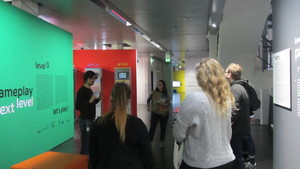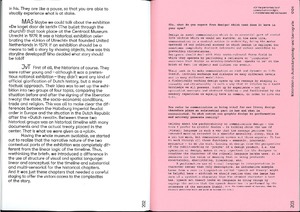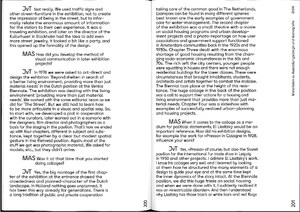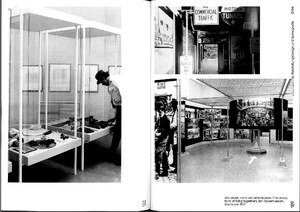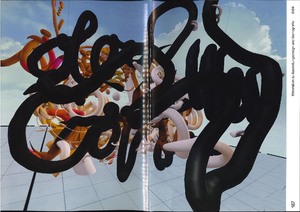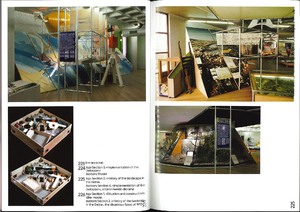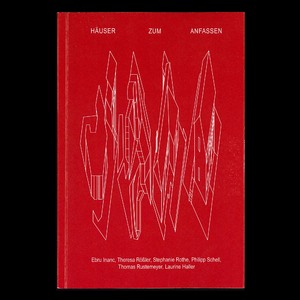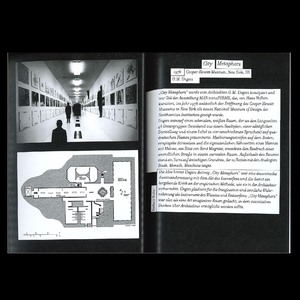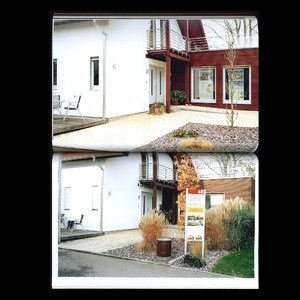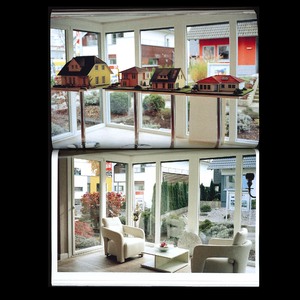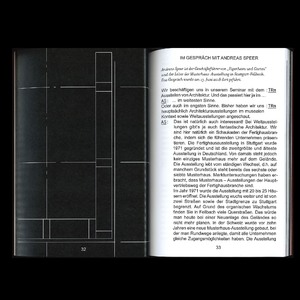"Wintersemester 2018/2019"
| Begriff | Wintersemester 2018/2019 |
| Metakey | Semester (institution:semester) |
| Typ | Keyword |
| Vokabular | HfG |
196 Inhalte
- Seite 1 von 17
Excursion Next Level
- Titel
- Excursion Next Level
- Autor/in
- Beschreibung (de)
- „Present Tense” beschäftigt sich mit unserer unmittelbaren Gegenwart: Wir leben in einer komplexen, krisenhaften Zeit, in der die Überlagerung von Klima- und Energiekrise, Postpandemie, Prekarität und Konkurrenz, gesellschaftlicher Radikalisierung bis hin zu näher rückenden Kriegen bereits jetzt gravierende Auswirkungen auf unser Leben und Arbeiten hat. Die Anspannung steigt, wir stehen vor dringlichen gesamtgesellschaftlichen Aufgaben und bewegen uns zugleich in Richtung eines Zustands chronischer Erschöpfung. Das etablierte Kunstfeld und die künstlerische und kulturelle Produktion sind davon nicht ausgenommen. Mit Künstler:innen, Kurator:innen und anderen Expert:innen des kulturellen Feldes möchten wir den Blick auf die aktuelle künstlerische Produktion und Ausstellungspraxis richten und die Frage nach möglichen (Zukunfts-)perspektiven für das Kunstfeld diskutieren:
Welche gesellschaftliche Rolle können und müssen Kunst und ihre Produzent:innen in einer sich radikal verändernden Welt einnehmen? Wie können Kunst- und Kulturinstitutionen zu Orten aktiver gesellschaftlicher Transformation werden? Was bedeutet es, eine (ökologisch wie sozial) nachhaltige künstlerische und institutionelle Praxis in der digitalen Gegenwart zu entwickeln? Welche neuen Gemeinschaften brauchen wir, gerade im Hinblick auf die zunehmende gesellschaftliche Spaltung und Radikalisierung? Offensichtlich führt die krisenhafte Gegenwart u. a. dazu, dass sich Menschen nach autoritären Figuren und Programmen sehen – eine Aufgabe von Kunst und Kultur könnte es sein, andere, freiere Konzepte von Zukunft zu entwerfen.
Auch das Konzept der Fürsorge in der künstlerischen und kuratorischen Praxis wird Thema der Veranstaltung sein. Teil des Symposiums sind neben Vorträgen künstlerische Workshops, Interventionen und Performances, die wir als gleichwertige Formen der Wissensproduktion und -vermittlung begreifen.
Mit Beiträgen von Gin Bahc, Sascia Bailer, Constanze Fischbeck, Sina Hensel, Alistair Hudson, Anne Duk Hee Jordan, Valentina Karga, Matriarchale Volksküche, Jacob Ott und Dorothee Richter.
- „Present Tense” beschäftigt sich mit unserer unmittelbaren Gegenwart: Wir leben in einer komplexen, krisenhaften Zeit, in der die Überlagerung von Klima- und Energiekrise, Postpandemie, Prekarität und Konkurrenz, gesellschaftlicher Radikalisierung bis hin zu näher rückenden Kriegen bereits jetzt gravierende Auswirkungen auf unser Leben und Arbeiten hat. Die Anspannung steigt, wir stehen vor dringlichen gesamtgesellschaftlichen Aufgaben und bewegen uns zugleich in Richtung eines Zustands chronischer Erschöpfung. Das etablierte Kunstfeld und die künstlerische und kulturelle Produktion sind davon nicht ausgenommen. Mit Künstler:innen, Kurator:innen und anderen Expert:innen des kulturellen Feldes möchten wir den Blick auf die aktuelle künstlerische Produktion und Ausstellungspraxis richten und die Frage nach möglichen (Zukunfts-)perspektiven für das Kunstfeld diskutieren:
- Beschreibung (en)
- „Present Tense” concerns itself with our immediate present: We live in a complex, crisis-filled age in which the overlapping of climate and energy crisis, post-pandemic times, precarity, social radicalisation and even impending wars already govern our lives and work. Tension is rising, we are faced with imperative responsibilities for society as a whole and are, at the same time, moving towards a state of chronic exhaustion. There is no exception for the field of arts and artistic and cultural production.
Together with artists, curators and other experts from the cultural field, we would like to examine current artistic productions and exhibition practices and discuss possibilities for the (future) perspectives of the arts. Which roles within society can and must art and its producers embrace in a radically changing world? How can art and cultural institutions become venues of active social transformation? What does it mean to develop an (ecologically as well as socially) sustainable artistic and institutional practice in the digital present? The concept of care within artistic and curatorial practices will be a topic of the event as well.
What new relationships do we need, especially in view of intensifying social division and radicalisation? Obviously, the crisis-filled present among other things leads to people looking to authoritarian figures and programmes – one of the tasks for art and culture could be to design other, more independent and free concepts of the future.
In addition to lectures and panels, the symposium will include artistic workshops, interventions and performances, which are also forms of knowledge production and dissemination that we feel to be of equal importance.
With contributions from Gin Bahc, Sascia Bailer, Constanze Fischbeck, Sina Hensel, Alistair Hudson, Anne Duk Hee Jordan, Valentina Karga, Matriarchale Volksküche, Jacob Ott and Dorothee Richter
- „Present Tense” concerns itself with our immediate present: We live in a complex, crisis-filled age in which the overlapping of climate and energy crisis, post-pandemic times, precarity, social radicalisation and even impending wars already govern our lives and work. Tension is rising, we are faced with imperative responsibilities for society as a whole and are, at the same time, moving towards a state of chronic exhaustion. There is no exception for the field of arts and artistic and cultural production.
- Typ des Projekts/Werks
- Schlagworte
- Datierung
- 19.02.2019
- Mitwirkende
- Ort: Institution
- Ort
- Lichthof, R.112
- Stadt
- Land
- Beteiligte Institution(en)
- Titel
- Excursion Next Level
- Urheberrechtshinweis
- Víctor Fancelli Capdevila / GameLab / Hochschule für Gestaltung
- Medienersteller/in
- Projektleiter/in
- Semester
- Lehrveranstaltung
- Importiert am
- 14.02.2019
- Übergeordnete Sets
- 1
MAS 004
- Titel
- MAS 004
- Untertitel
- Jan van Toorn, Rethinking the Brief
- Autor/in
- Beschreibung (de)
- Die vierte Ausgabe von "Materialien für Ausstellungsdesign und Szenografie", MAS 004, widmet sich den Ausstellungsgestaltungen des niederländischen Kommunikationsdesigners Jan van Toorn. Bereits seit den frühen 1970er Jahren ist er für die Gestaltung von Kalendern, Postern und Katalogen, von denen viele für das Van Abbemuseum in Eindhoven entstanden sind, international bekannt. Van Toorn betrachtet Objektivität und Neutralität als Illusion, vielmehr versteht er jede gestalterische Handlung als subjektiven Ausdruck. Diese Überzeugung führte Jan van Toorn dazu, den “dialogischen Charakter“ von Design herauszuarbeiten. Seine Gestaltungen öffnen unterschiedliche Bedeutungsmöglichkeiten und sollen zu einer kritischen, nicht eindeutigen, Rezeption aktivieren. Die Produktion und Reflektion dialogischer Formen von Design verbindet Jan van Toorns mit der Arbeit der Kunsthistorikerin und Designtheoretikerin Els Kuijpers. In ihrer Forschung beschäftigt sie sich damit, wie Sprache – visuell und schriftlich – Bedeutung in dynamischen sozialen Gefügen herstellt. Um Designtheorie und -praxis zusammenzuführen, “in thinking and making” wie sie sagen, untersuchen sie die Inszenierung von Botschaften und haben daraus eine spezielle editoriale Gestaltungsmethode entwickelt.
Im Frühjahr 2017 lud van Toorn die MAS-Redaktion nach Amsterdam ein, wo ein Gespräch und eine extensive Materialsichtung von seinen Ausstellungsgestaltungen und Katalogen stattfand. MAS 004 vermittelt anhand von fünf Ausstellungsbeispielen Jan van Toorns Begriff von visueller Kommunikation im Raum, einer Form der körperlichen Erfahrung der Inhalte, einem Lesen ohne Text. Ergänzt wird dieses Material durch ein E-mail-Interview mit Els Kuijpers, in welchem es um die Performativität und Erfahrung von Gestaltung geht, sowie um die Möglichkeiten der Übersetzung von gestalterischer Praxis in Sprache.
- Die vierte Ausgabe von "Materialien für Ausstellungsdesign und Szenografie", MAS 004, widmet sich den Ausstellungsgestaltungen des niederländischen Kommunikationsdesigners Jan van Toorn. Bereits seit den frühen 1970er Jahren ist er für die Gestaltung von Kalendern, Postern und Katalogen, von denen viele für das Van Abbemuseum in Eindhoven entstanden sind, international bekannt. Van Toorn betrachtet Objektivität und Neutralität als Illusion, vielmehr versteht er jede gestalterische Handlung als subjektiven Ausdruck. Diese Überzeugung führte Jan van Toorn dazu, den “dialogischen Charakter“ von Design herauszuarbeiten. Seine Gestaltungen öffnen unterschiedliche Bedeutungsmöglichkeiten und sollen zu einer kritischen, nicht eindeutigen, Rezeption aktivieren. Die Produktion und Reflektion dialogischer Formen von Design verbindet Jan van Toorns mit der Arbeit der Kunsthistorikerin und Designtheoretikerin Els Kuijpers. In ihrer Forschung beschäftigt sie sich damit, wie Sprache – visuell und schriftlich – Bedeutung in dynamischen sozialen Gefügen herstellt. Um Designtheorie und -praxis zusammenzuführen, “in thinking and making” wie sie sagen, untersuchen sie die Inszenierung von Botschaften und haben daraus eine spezielle editoriale Gestaltungsmethode entwickelt.
- Beschreibung (en)
- The fourth edition of "Materials for Exhibition Design and Scenography", MAS 004, is dedicated to the exhibition designs of Dutch communication designer Jan van Toorn. He has been internationally renowned since the early 1970s for the design of calendars, posters and catalogs, many of which were created for the Van Abbemuseum in Eindhoven. Van Toorn regards objectivity and neutrality as an illusion; rather, he sees every creative act as a subjective expression. This conviction led Jan van Toorn to work out the "dialogical character" of design. His designs open up different possibilities of meaning and are intended to encourage a critical, ambiguous reception. Jan van Toorn's production and reflection of dialogical forms of design is linked to the work of art historian and design theorist Els Kuijpers. Her research focuses on how language - visual and written - creates meaning in dynamic social structures. In order to bring together design theory and practice, "in thinking and making" as they say, they examine the staging of messages and have developed a special editorial design method from this.
In spring 2017, van Toorn invited the MAS editorial team to Amsterdam, where a discussion and extensive material review of his exhibition designs and catalogs took place. MAS 004 uses five exhibition examples to convey Jan van Toorn's concept of visual communication in space, a form of physical experience of content, a reading without text. This material is supplemented by an e-mail interview with Els Kuijpers, which deals with the performativity and experience of design, as well as the possibilities of translating design practice into language.
- The fourth edition of "Materials for Exhibition Design and Scenography", MAS 004, is dedicated to the exhibition designs of Dutch communication designer Jan van Toorn. He has been internationally renowned since the early 1970s for the design of calendars, posters and catalogs, many of which were created for the Van Abbemuseum in Eindhoven. Van Toorn regards objectivity and neutrality as an illusion; rather, he sees every creative act as a subjective expression. This conviction led Jan van Toorn to work out the "dialogical character" of design. His designs open up different possibilities of meaning and are intended to encourage a critical, ambiguous reception. Jan van Toorn's production and reflection of dialogical forms of design is linked to the work of art historian and design theorist Els Kuijpers. Her research focuses on how language - visual and written - creates meaning in dynamic social structures. In order to bring together design theory and practice, "in thinking and making" as they say, they examine the staging of messages and have developed a special editorial design method from this.
- Typ des Projekts/Werks
- Schlagworte
- Mitwirkende
- Sprache
- Abmessungen
- DIN A4
- Ort: Institution
- Stadt
- Land
- Bemerkungen
- Heft 4: Jan van Toorn
44 Seiten
30 Abb., farbig & s/w
Cover: Anja Kirschner, „Review of Practice, Any day of the week, any week of any future year, or, perhaps this year“. 90102122 (3D object/drawing made in Oculus Medium, Anja Kirschner, 2018)
Grafik Credits: Bruno Jacoby, Moritz Appich
- Heft 4: Jan van Toorn
- Titel
- MAS 004
- Urheberrechtshinweis
- Ausstellungsdesign und Szenografie, Staatliche Hochschule für Gestaltung; Cover: Anja Kirschner; Grafik: Bruno Jacoby, Moritz Appich
- Rechtsschutz/Lizenz
- Medienersteller/in
- Beziehung/Funktion
- Projektleiter/in
- Semester
- Lehrveranstaltung
- Importiert am
- 24.05.2023
- Übergeordnete Sets
- 1
MAS 004
- Titel
- MAS 004
- Untertitel
- Jan van Toorn, Rethinking the Brief
- Autor/in
- Beschreibung (de)
- Die vierte Ausgabe von "Materialien für Ausstellungsdesign und Szenografie", MAS 004, widmet sich den Ausstellungsgestaltungen des niederländischen Kommunikationsdesigners Jan van Toorn. Bereits seit den frühen 1970er Jahren ist er für die Gestaltung von Kalendern, Postern und Katalogen, von denen viele für das Van Abbemuseum in Eindhoven entstanden sind, international bekannt. Van Toorn betrachtet Objektivität und Neutralität als Illusion, vielmehr versteht er jede gestalterische Handlung als subjektiven Ausdruck. Diese Überzeugung führte Jan van Toorn dazu, den “dialogischen Charakter“ von Design herauszuarbeiten. Seine Gestaltungen öffnen unterschiedliche Bedeutungsmöglichkeiten und sollen zu einer kritischen, nicht eindeutigen, Rezeption aktivieren. Die Produktion und Reflektion dialogischer Formen von Design verbindet Jan van Toorns mit der Arbeit der Kunsthistorikerin und Designtheoretikerin Els Kuijpers. In ihrer Forschung beschäftigt sie sich damit, wie Sprache – visuell und schriftlich – Bedeutung in dynamischen sozialen Gefügen herstellt. Um Designtheorie und -praxis zusammenzuführen, “in thinking and making” wie sie sagen, untersuchen sie die Inszenierung von Botschaften und haben daraus eine spezielle editoriale Gestaltungsmethode entwickelt.
Im Frühjahr 2017 lud van Toorn die MAS-Redaktion nach Amsterdam ein, wo ein Gespräch und eine extensive Materialsichtung von seinen Ausstellungsgestaltungen und Katalogen stattfand. MAS 004 vermittelt anhand von fünf Ausstellungsbeispielen Jan van Toorns Begriff von visueller Kommunikation im Raum, einer Form der körperlichen Erfahrung der Inhalte, einem Lesen ohne Text. Ergänzt wird dieses Material durch ein E-mail-Interview mit Els Kuijpers, in welchem es um die Performativität und Erfahrung von Gestaltung geht, sowie um die Möglichkeiten der Übersetzung von gestalterischer Praxis in Sprache.
- Die vierte Ausgabe von "Materialien für Ausstellungsdesign und Szenografie", MAS 004, widmet sich den Ausstellungsgestaltungen des niederländischen Kommunikationsdesigners Jan van Toorn. Bereits seit den frühen 1970er Jahren ist er für die Gestaltung von Kalendern, Postern und Katalogen, von denen viele für das Van Abbemuseum in Eindhoven entstanden sind, international bekannt. Van Toorn betrachtet Objektivität und Neutralität als Illusion, vielmehr versteht er jede gestalterische Handlung als subjektiven Ausdruck. Diese Überzeugung führte Jan van Toorn dazu, den “dialogischen Charakter“ von Design herauszuarbeiten. Seine Gestaltungen öffnen unterschiedliche Bedeutungsmöglichkeiten und sollen zu einer kritischen, nicht eindeutigen, Rezeption aktivieren. Die Produktion und Reflektion dialogischer Formen von Design verbindet Jan van Toorns mit der Arbeit der Kunsthistorikerin und Designtheoretikerin Els Kuijpers. In ihrer Forschung beschäftigt sie sich damit, wie Sprache – visuell und schriftlich – Bedeutung in dynamischen sozialen Gefügen herstellt. Um Designtheorie und -praxis zusammenzuführen, “in thinking and making” wie sie sagen, untersuchen sie die Inszenierung von Botschaften und haben daraus eine spezielle editoriale Gestaltungsmethode entwickelt.
- Beschreibung (en)
- The fourth edition of "Materials for Exhibition Design and Scenography", MAS 004, is dedicated to the exhibition designs of Dutch communication designer Jan van Toorn. He has been internationally renowned since the early 1970s for the design of calendars, posters and catalogs, many of which were created for the Van Abbemuseum in Eindhoven. Van Toorn regards objectivity and neutrality as an illusion; rather, he sees every creative act as a subjective expression. This conviction led Jan van Toorn to work out the "dialogical character" of design. His designs open up different possibilities of meaning and are intended to encourage a critical, ambiguous reception. Jan van Toorn's production and reflection of dialogical forms of design is linked to the work of art historian and design theorist Els Kuijpers. Her research focuses on how language - visual and written - creates meaning in dynamic social structures. In order to bring together design theory and practice, "in thinking and making" as they say, they examine the staging of messages and have developed a special editorial design method from this.
In spring 2017, van Toorn invited the MAS editorial team to Amsterdam, where a discussion and extensive material review of his exhibition designs and catalogs took place. MAS 004 uses five exhibition examples to convey Jan van Toorn's concept of visual communication in space, a form of physical experience of content, a reading without text. This material is supplemented by an e-mail interview with Els Kuijpers, which deals with the performativity and experience of design, as well as the possibilities of translating design practice into language.
- The fourth edition of "Materials for Exhibition Design and Scenography", MAS 004, is dedicated to the exhibition designs of Dutch communication designer Jan van Toorn. He has been internationally renowned since the early 1970s for the design of calendars, posters and catalogs, many of which were created for the Van Abbemuseum in Eindhoven. Van Toorn regards objectivity and neutrality as an illusion; rather, he sees every creative act as a subjective expression. This conviction led Jan van Toorn to work out the "dialogical character" of design. His designs open up different possibilities of meaning and are intended to encourage a critical, ambiguous reception. Jan van Toorn's production and reflection of dialogical forms of design is linked to the work of art historian and design theorist Els Kuijpers. Her research focuses on how language - visual and written - creates meaning in dynamic social structures. In order to bring together design theory and practice, "in thinking and making" as they say, they examine the staging of messages and have developed a special editorial design method from this.
- Typ des Projekts/Werks
- Schlagworte
- Mitwirkende
- Sprache
- Abmessungen
- DIN A4
- Ort: Institution
- Stadt
- Land
- Bemerkungen
- Heft 4: Jan van Toorn
44 Seiten
30 Abb., farbig & s/w
Cover: Anja Kirschner, „Review of Practice, Any day of the week, any week of any future year, or, perhaps this year“. 90102122 (3D object/drawing made in Oculus Medium, Anja Kirschner, 2018)
Grafik Credits: Bruno Jacoby, Moritz Appich
- Heft 4: Jan van Toorn
- Titel
- MAS 004
- Urheberrechtshinweis
- Ausstellungsdesign und Szenografie, Staatliche Hochschule für Gestaltung; Cover: Anja Kirschner; Grafik: Bruno Jacoby, Moritz Appich
- Rechtsschutz/Lizenz
- Medienersteller/in
- Beziehung/Funktion
- Projektleiter/in
- Semester
- Lehrveranstaltung
- Importiert am
- 24.05.2023
- Übergeordnete Sets
- 1
MAS 004
- Titel
- MAS 004
- Untertitel
- Jan van Toorn, Rethinking the Brief
- Autor/in
- Beschreibung (de)
- Die vierte Ausgabe von "Materialien für Ausstellungsdesign und Szenografie", MAS 004, widmet sich den Ausstellungsgestaltungen des niederländischen Kommunikationsdesigners Jan van Toorn. Bereits seit den frühen 1970er Jahren ist er für die Gestaltung von Kalendern, Postern und Katalogen, von denen viele für das Van Abbemuseum in Eindhoven entstanden sind, international bekannt. Van Toorn betrachtet Objektivität und Neutralität als Illusion, vielmehr versteht er jede gestalterische Handlung als subjektiven Ausdruck. Diese Überzeugung führte Jan van Toorn dazu, den “dialogischen Charakter“ von Design herauszuarbeiten. Seine Gestaltungen öffnen unterschiedliche Bedeutungsmöglichkeiten und sollen zu einer kritischen, nicht eindeutigen, Rezeption aktivieren. Die Produktion und Reflektion dialogischer Formen von Design verbindet Jan van Toorns mit der Arbeit der Kunsthistorikerin und Designtheoretikerin Els Kuijpers. In ihrer Forschung beschäftigt sie sich damit, wie Sprache – visuell und schriftlich – Bedeutung in dynamischen sozialen Gefügen herstellt. Um Designtheorie und -praxis zusammenzuführen, “in thinking and making” wie sie sagen, untersuchen sie die Inszenierung von Botschaften und haben daraus eine spezielle editoriale Gestaltungsmethode entwickelt.
Im Frühjahr 2017 lud van Toorn die MAS-Redaktion nach Amsterdam ein, wo ein Gespräch und eine extensive Materialsichtung von seinen Ausstellungsgestaltungen und Katalogen stattfand. MAS 004 vermittelt anhand von fünf Ausstellungsbeispielen Jan van Toorns Begriff von visueller Kommunikation im Raum, einer Form der körperlichen Erfahrung der Inhalte, einem Lesen ohne Text. Ergänzt wird dieses Material durch ein E-mail-Interview mit Els Kuijpers, in welchem es um die Performativität und Erfahrung von Gestaltung geht, sowie um die Möglichkeiten der Übersetzung von gestalterischer Praxis in Sprache.
- Die vierte Ausgabe von "Materialien für Ausstellungsdesign und Szenografie", MAS 004, widmet sich den Ausstellungsgestaltungen des niederländischen Kommunikationsdesigners Jan van Toorn. Bereits seit den frühen 1970er Jahren ist er für die Gestaltung von Kalendern, Postern und Katalogen, von denen viele für das Van Abbemuseum in Eindhoven entstanden sind, international bekannt. Van Toorn betrachtet Objektivität und Neutralität als Illusion, vielmehr versteht er jede gestalterische Handlung als subjektiven Ausdruck. Diese Überzeugung führte Jan van Toorn dazu, den “dialogischen Charakter“ von Design herauszuarbeiten. Seine Gestaltungen öffnen unterschiedliche Bedeutungsmöglichkeiten und sollen zu einer kritischen, nicht eindeutigen, Rezeption aktivieren. Die Produktion und Reflektion dialogischer Formen von Design verbindet Jan van Toorns mit der Arbeit der Kunsthistorikerin und Designtheoretikerin Els Kuijpers. In ihrer Forschung beschäftigt sie sich damit, wie Sprache – visuell und schriftlich – Bedeutung in dynamischen sozialen Gefügen herstellt. Um Designtheorie und -praxis zusammenzuführen, “in thinking and making” wie sie sagen, untersuchen sie die Inszenierung von Botschaften und haben daraus eine spezielle editoriale Gestaltungsmethode entwickelt.
- Beschreibung (en)
- The fourth edition of "Materials for Exhibition Design and Scenography", MAS 004, is dedicated to the exhibition designs of Dutch communication designer Jan van Toorn. He has been internationally renowned since the early 1970s for the design of calendars, posters and catalogs, many of which were created for the Van Abbemuseum in Eindhoven. Van Toorn regards objectivity and neutrality as an illusion; rather, he sees every creative act as a subjective expression. This conviction led Jan van Toorn to work out the "dialogical character" of design. His designs open up different possibilities of meaning and are intended to encourage a critical, ambiguous reception. Jan van Toorn's production and reflection of dialogical forms of design is linked to the work of art historian and design theorist Els Kuijpers. Her research focuses on how language - visual and written - creates meaning in dynamic social structures. In order to bring together design theory and practice, "in thinking and making" as they say, they examine the staging of messages and have developed a special editorial design method from this.
In spring 2017, van Toorn invited the MAS editorial team to Amsterdam, where a discussion and extensive material review of his exhibition designs and catalogs took place. MAS 004 uses five exhibition examples to convey Jan van Toorn's concept of visual communication in space, a form of physical experience of content, a reading without text. This material is supplemented by an e-mail interview with Els Kuijpers, which deals with the performativity and experience of design, as well as the possibilities of translating design practice into language.
- The fourth edition of "Materials for Exhibition Design and Scenography", MAS 004, is dedicated to the exhibition designs of Dutch communication designer Jan van Toorn. He has been internationally renowned since the early 1970s for the design of calendars, posters and catalogs, many of which were created for the Van Abbemuseum in Eindhoven. Van Toorn regards objectivity and neutrality as an illusion; rather, he sees every creative act as a subjective expression. This conviction led Jan van Toorn to work out the "dialogical character" of design. His designs open up different possibilities of meaning and are intended to encourage a critical, ambiguous reception. Jan van Toorn's production and reflection of dialogical forms of design is linked to the work of art historian and design theorist Els Kuijpers. Her research focuses on how language - visual and written - creates meaning in dynamic social structures. In order to bring together design theory and practice, "in thinking and making" as they say, they examine the staging of messages and have developed a special editorial design method from this.
- Typ des Projekts/Werks
- Schlagworte
- Mitwirkende
- Sprache
- Abmessungen
- DIN A4
- Ort: Institution
- Stadt
- Land
- Bemerkungen
- Heft 4: Jan van Toorn
44 Seiten
30 Abb., farbig & s/w
Cover: Anja Kirschner, „Review of Practice, Any day of the week, any week of any future year, or, perhaps this year“. 90102122 (3D object/drawing made in Oculus Medium, Anja Kirschner, 2018)
Grafik Credits: Bruno Jacoby, Moritz Appich
- Heft 4: Jan van Toorn
- Titel
- MAS 004
- Urheberrechtshinweis
- Ausstellungsdesign und Szenografie, Staatliche Hochschule für Gestaltung; Cover: Anja Kirschner; Grafik: Bruno Jacoby, Moritz Appich
- Rechtsschutz/Lizenz
- Medienersteller/in
- Beziehung/Funktion
- Projektleiter/in
- Semester
- Lehrveranstaltung
- Importiert am
- 24.05.2023
- Übergeordnete Sets
- 1
MAS 004
- Titel
- MAS 004
- Untertitel
- Jan van Toorn, Rethinking the Brief
- Autor/in
- Beschreibung (de)
- Die vierte Ausgabe von "Materialien für Ausstellungsdesign und Szenografie", MAS 004, widmet sich den Ausstellungsgestaltungen des niederländischen Kommunikationsdesigners Jan van Toorn. Bereits seit den frühen 1970er Jahren ist er für die Gestaltung von Kalendern, Postern und Katalogen, von denen viele für das Van Abbemuseum in Eindhoven entstanden sind, international bekannt. Van Toorn betrachtet Objektivität und Neutralität als Illusion, vielmehr versteht er jede gestalterische Handlung als subjektiven Ausdruck. Diese Überzeugung führte Jan van Toorn dazu, den “dialogischen Charakter“ von Design herauszuarbeiten. Seine Gestaltungen öffnen unterschiedliche Bedeutungsmöglichkeiten und sollen zu einer kritischen, nicht eindeutigen, Rezeption aktivieren. Die Produktion und Reflektion dialogischer Formen von Design verbindet Jan van Toorns mit der Arbeit der Kunsthistorikerin und Designtheoretikerin Els Kuijpers. In ihrer Forschung beschäftigt sie sich damit, wie Sprache – visuell und schriftlich – Bedeutung in dynamischen sozialen Gefügen herstellt. Um Designtheorie und -praxis zusammenzuführen, “in thinking and making” wie sie sagen, untersuchen sie die Inszenierung von Botschaften und haben daraus eine spezielle editoriale Gestaltungsmethode entwickelt.
Im Frühjahr 2017 lud van Toorn die MAS-Redaktion nach Amsterdam ein, wo ein Gespräch und eine extensive Materialsichtung von seinen Ausstellungsgestaltungen und Katalogen stattfand. MAS 004 vermittelt anhand von fünf Ausstellungsbeispielen Jan van Toorns Begriff von visueller Kommunikation im Raum, einer Form der körperlichen Erfahrung der Inhalte, einem Lesen ohne Text. Ergänzt wird dieses Material durch ein E-mail-Interview mit Els Kuijpers, in welchem es um die Performativität und Erfahrung von Gestaltung geht, sowie um die Möglichkeiten der Übersetzung von gestalterischer Praxis in Sprache.
- Die vierte Ausgabe von "Materialien für Ausstellungsdesign und Szenografie", MAS 004, widmet sich den Ausstellungsgestaltungen des niederländischen Kommunikationsdesigners Jan van Toorn. Bereits seit den frühen 1970er Jahren ist er für die Gestaltung von Kalendern, Postern und Katalogen, von denen viele für das Van Abbemuseum in Eindhoven entstanden sind, international bekannt. Van Toorn betrachtet Objektivität und Neutralität als Illusion, vielmehr versteht er jede gestalterische Handlung als subjektiven Ausdruck. Diese Überzeugung führte Jan van Toorn dazu, den “dialogischen Charakter“ von Design herauszuarbeiten. Seine Gestaltungen öffnen unterschiedliche Bedeutungsmöglichkeiten und sollen zu einer kritischen, nicht eindeutigen, Rezeption aktivieren. Die Produktion und Reflektion dialogischer Formen von Design verbindet Jan van Toorns mit der Arbeit der Kunsthistorikerin und Designtheoretikerin Els Kuijpers. In ihrer Forschung beschäftigt sie sich damit, wie Sprache – visuell und schriftlich – Bedeutung in dynamischen sozialen Gefügen herstellt. Um Designtheorie und -praxis zusammenzuführen, “in thinking and making” wie sie sagen, untersuchen sie die Inszenierung von Botschaften und haben daraus eine spezielle editoriale Gestaltungsmethode entwickelt.
- Beschreibung (en)
- The fourth edition of "Materials for Exhibition Design and Scenography", MAS 004, is dedicated to the exhibition designs of Dutch communication designer Jan van Toorn. He has been internationally renowned since the early 1970s for the design of calendars, posters and catalogs, many of which were created for the Van Abbemuseum in Eindhoven. Van Toorn regards objectivity and neutrality as an illusion; rather, he sees every creative act as a subjective expression. This conviction led Jan van Toorn to work out the "dialogical character" of design. His designs open up different possibilities of meaning and are intended to encourage a critical, ambiguous reception. Jan van Toorn's production and reflection of dialogical forms of design is linked to the work of art historian and design theorist Els Kuijpers. Her research focuses on how language - visual and written - creates meaning in dynamic social structures. In order to bring together design theory and practice, "in thinking and making" as they say, they examine the staging of messages and have developed a special editorial design method from this.
In spring 2017, van Toorn invited the MAS editorial team to Amsterdam, where a discussion and extensive material review of his exhibition designs and catalogs took place. MAS 004 uses five exhibition examples to convey Jan van Toorn's concept of visual communication in space, a form of physical experience of content, a reading without text. This material is supplemented by an e-mail interview with Els Kuijpers, which deals with the performativity and experience of design, as well as the possibilities of translating design practice into language.
- The fourth edition of "Materials for Exhibition Design and Scenography", MAS 004, is dedicated to the exhibition designs of Dutch communication designer Jan van Toorn. He has been internationally renowned since the early 1970s for the design of calendars, posters and catalogs, many of which were created for the Van Abbemuseum in Eindhoven. Van Toorn regards objectivity and neutrality as an illusion; rather, he sees every creative act as a subjective expression. This conviction led Jan van Toorn to work out the "dialogical character" of design. His designs open up different possibilities of meaning and are intended to encourage a critical, ambiguous reception. Jan van Toorn's production and reflection of dialogical forms of design is linked to the work of art historian and design theorist Els Kuijpers. Her research focuses on how language - visual and written - creates meaning in dynamic social structures. In order to bring together design theory and practice, "in thinking and making" as they say, they examine the staging of messages and have developed a special editorial design method from this.
- Typ des Projekts/Werks
- Schlagworte
- Mitwirkende
- Sprache
- Abmessungen
- DIN A4
- Ort: Institution
- Stadt
- Land
- Bemerkungen
- Heft 4: Jan van Toorn
44 Seiten
30 Abb., farbig & s/w
Cover: Anja Kirschner, „Review of Practice, Any day of the week, any week of any future year, or, perhaps this year“. 90102122 (3D object/drawing made in Oculus Medium, Anja Kirschner, 2018)
Grafik Credits: Bruno Jacoby, Moritz Appich
- Heft 4: Jan van Toorn
- Titel
- MAS 004
- Urheberrechtshinweis
- Ausstellungsdesign und Szenografie, Staatliche Hochschule für Gestaltung; Cover: Anja Kirschner; Grafik: Bruno Jacoby, Moritz Appich
- Rechtsschutz/Lizenz
- Medienersteller/in
- Beziehung/Funktion
- Projektleiter/in
- Semester
- Lehrveranstaltung
- Importiert am
- 24.05.2023
- Übergeordnete Sets
- 1
MAS 004
- Titel
- MAS 004
- Untertitel
- Jan van Toorn, Rethinking the Brief
- Autor/in
- Beschreibung (de)
- Die vierte Ausgabe von "Materialien für Ausstellungsdesign und Szenografie", MAS 004, widmet sich den Ausstellungsgestaltungen des niederländischen Kommunikationsdesigners Jan van Toorn. Bereits seit den frühen 1970er Jahren ist er für die Gestaltung von Kalendern, Postern und Katalogen, von denen viele für das Van Abbemuseum in Eindhoven entstanden sind, international bekannt. Van Toorn betrachtet Objektivität und Neutralität als Illusion, vielmehr versteht er jede gestalterische Handlung als subjektiven Ausdruck. Diese Überzeugung führte Jan van Toorn dazu, den “dialogischen Charakter“ von Design herauszuarbeiten. Seine Gestaltungen öffnen unterschiedliche Bedeutungsmöglichkeiten und sollen zu einer kritischen, nicht eindeutigen, Rezeption aktivieren. Die Produktion und Reflektion dialogischer Formen von Design verbindet Jan van Toorns mit der Arbeit der Kunsthistorikerin und Designtheoretikerin Els Kuijpers. In ihrer Forschung beschäftigt sie sich damit, wie Sprache – visuell und schriftlich – Bedeutung in dynamischen sozialen Gefügen herstellt. Um Designtheorie und -praxis zusammenzuführen, “in thinking and making” wie sie sagen, untersuchen sie die Inszenierung von Botschaften und haben daraus eine spezielle editoriale Gestaltungsmethode entwickelt.
Im Frühjahr 2017 lud van Toorn die MAS-Redaktion nach Amsterdam ein, wo ein Gespräch und eine extensive Materialsichtung von seinen Ausstellungsgestaltungen und Katalogen stattfand. MAS 004 vermittelt anhand von fünf Ausstellungsbeispielen Jan van Toorns Begriff von visueller Kommunikation im Raum, einer Form der körperlichen Erfahrung der Inhalte, einem Lesen ohne Text. Ergänzt wird dieses Material durch ein E-mail-Interview mit Els Kuijpers, in welchem es um die Performativität und Erfahrung von Gestaltung geht, sowie um die Möglichkeiten der Übersetzung von gestalterischer Praxis in Sprache.
- Die vierte Ausgabe von "Materialien für Ausstellungsdesign und Szenografie", MAS 004, widmet sich den Ausstellungsgestaltungen des niederländischen Kommunikationsdesigners Jan van Toorn. Bereits seit den frühen 1970er Jahren ist er für die Gestaltung von Kalendern, Postern und Katalogen, von denen viele für das Van Abbemuseum in Eindhoven entstanden sind, international bekannt. Van Toorn betrachtet Objektivität und Neutralität als Illusion, vielmehr versteht er jede gestalterische Handlung als subjektiven Ausdruck. Diese Überzeugung führte Jan van Toorn dazu, den “dialogischen Charakter“ von Design herauszuarbeiten. Seine Gestaltungen öffnen unterschiedliche Bedeutungsmöglichkeiten und sollen zu einer kritischen, nicht eindeutigen, Rezeption aktivieren. Die Produktion und Reflektion dialogischer Formen von Design verbindet Jan van Toorns mit der Arbeit der Kunsthistorikerin und Designtheoretikerin Els Kuijpers. In ihrer Forschung beschäftigt sie sich damit, wie Sprache – visuell und schriftlich – Bedeutung in dynamischen sozialen Gefügen herstellt. Um Designtheorie und -praxis zusammenzuführen, “in thinking and making” wie sie sagen, untersuchen sie die Inszenierung von Botschaften und haben daraus eine spezielle editoriale Gestaltungsmethode entwickelt.
- Beschreibung (en)
- The fourth edition of "Materials for Exhibition Design and Scenography", MAS 004, is dedicated to the exhibition designs of Dutch communication designer Jan van Toorn. He has been internationally renowned since the early 1970s for the design of calendars, posters and catalogs, many of which were created for the Van Abbemuseum in Eindhoven. Van Toorn regards objectivity and neutrality as an illusion; rather, he sees every creative act as a subjective expression. This conviction led Jan van Toorn to work out the "dialogical character" of design. His designs open up different possibilities of meaning and are intended to encourage a critical, ambiguous reception. Jan van Toorn's production and reflection of dialogical forms of design is linked to the work of art historian and design theorist Els Kuijpers. Her research focuses on how language - visual and written - creates meaning in dynamic social structures. In order to bring together design theory and practice, "in thinking and making" as they say, they examine the staging of messages and have developed a special editorial design method from this.
In spring 2017, van Toorn invited the MAS editorial team to Amsterdam, where a discussion and extensive material review of his exhibition designs and catalogs took place. MAS 004 uses five exhibition examples to convey Jan van Toorn's concept of visual communication in space, a form of physical experience of content, a reading without text. This material is supplemented by an e-mail interview with Els Kuijpers, which deals with the performativity and experience of design, as well as the possibilities of translating design practice into language.
- The fourth edition of "Materials for Exhibition Design and Scenography", MAS 004, is dedicated to the exhibition designs of Dutch communication designer Jan van Toorn. He has been internationally renowned since the early 1970s for the design of calendars, posters and catalogs, many of which were created for the Van Abbemuseum in Eindhoven. Van Toorn regards objectivity and neutrality as an illusion; rather, he sees every creative act as a subjective expression. This conviction led Jan van Toorn to work out the "dialogical character" of design. His designs open up different possibilities of meaning and are intended to encourage a critical, ambiguous reception. Jan van Toorn's production and reflection of dialogical forms of design is linked to the work of art historian and design theorist Els Kuijpers. Her research focuses on how language - visual and written - creates meaning in dynamic social structures. In order to bring together design theory and practice, "in thinking and making" as they say, they examine the staging of messages and have developed a special editorial design method from this.
- Typ des Projekts/Werks
- Schlagworte
- Mitwirkende
- Sprache
- Abmessungen
- DIN A4
- Ort: Institution
- Stadt
- Land
- Bemerkungen
- Heft 4: Jan van Toorn
44 Seiten
30 Abb., farbig & s/w
Cover: Anja Kirschner, „Review of Practice, Any day of the week, any week of any future year, or, perhaps this year“. 90102122 (3D object/drawing made in Oculus Medium, Anja Kirschner, 2018)
Grafik Credits: Bruno Jacoby, Moritz Appich
- Heft 4: Jan van Toorn
- Titel
- MAS 004
- Urheberrechtshinweis
- Ausstellungsdesign und Szenografie, Staatliche Hochschule für Gestaltung; Cover: Anja Kirschner; Grafik: Bruno Jacoby, Moritz Appich
- Rechtsschutz/Lizenz
- Medienersteller/in
- Beziehung/Funktion
- Projektleiter/in
- Semester
- Lehrveranstaltung
- Importiert am
- 24.05.2023
- Übergeordnete Sets
- 1
MAS 004
- Titel
- MAS 004
- Untertitel
- Jan van Toorn, Rethinking the Brief
- Autor/in
- Beschreibung (de)
- Die vierte Ausgabe von "Materialien für Ausstellungsdesign und Szenografie", MAS 004, widmet sich den Ausstellungsgestaltungen des niederländischen Kommunikationsdesigners Jan van Toorn. Bereits seit den frühen 1970er Jahren ist er für die Gestaltung von Kalendern, Postern und Katalogen, von denen viele für das Van Abbemuseum in Eindhoven entstanden sind, international bekannt. Van Toorn betrachtet Objektivität und Neutralität als Illusion, vielmehr versteht er jede gestalterische Handlung als subjektiven Ausdruck. Diese Überzeugung führte Jan van Toorn dazu, den “dialogischen Charakter“ von Design herauszuarbeiten. Seine Gestaltungen öffnen unterschiedliche Bedeutungsmöglichkeiten und sollen zu einer kritischen, nicht eindeutigen, Rezeption aktivieren. Die Produktion und Reflektion dialogischer Formen von Design verbindet Jan van Toorns mit der Arbeit der Kunsthistorikerin und Designtheoretikerin Els Kuijpers. In ihrer Forschung beschäftigt sie sich damit, wie Sprache – visuell und schriftlich – Bedeutung in dynamischen sozialen Gefügen herstellt. Um Designtheorie und -praxis zusammenzuführen, “in thinking and making” wie sie sagen, untersuchen sie die Inszenierung von Botschaften und haben daraus eine spezielle editoriale Gestaltungsmethode entwickelt.
Im Frühjahr 2017 lud van Toorn die MAS-Redaktion nach Amsterdam ein, wo ein Gespräch und eine extensive Materialsichtung von seinen Ausstellungsgestaltungen und Katalogen stattfand. MAS 004 vermittelt anhand von fünf Ausstellungsbeispielen Jan van Toorns Begriff von visueller Kommunikation im Raum, einer Form der körperlichen Erfahrung der Inhalte, einem Lesen ohne Text. Ergänzt wird dieses Material durch ein E-mail-Interview mit Els Kuijpers, in welchem es um die Performativität und Erfahrung von Gestaltung geht, sowie um die Möglichkeiten der Übersetzung von gestalterischer Praxis in Sprache.
- Die vierte Ausgabe von "Materialien für Ausstellungsdesign und Szenografie", MAS 004, widmet sich den Ausstellungsgestaltungen des niederländischen Kommunikationsdesigners Jan van Toorn. Bereits seit den frühen 1970er Jahren ist er für die Gestaltung von Kalendern, Postern und Katalogen, von denen viele für das Van Abbemuseum in Eindhoven entstanden sind, international bekannt. Van Toorn betrachtet Objektivität und Neutralität als Illusion, vielmehr versteht er jede gestalterische Handlung als subjektiven Ausdruck. Diese Überzeugung führte Jan van Toorn dazu, den “dialogischen Charakter“ von Design herauszuarbeiten. Seine Gestaltungen öffnen unterschiedliche Bedeutungsmöglichkeiten und sollen zu einer kritischen, nicht eindeutigen, Rezeption aktivieren. Die Produktion und Reflektion dialogischer Formen von Design verbindet Jan van Toorns mit der Arbeit der Kunsthistorikerin und Designtheoretikerin Els Kuijpers. In ihrer Forschung beschäftigt sie sich damit, wie Sprache – visuell und schriftlich – Bedeutung in dynamischen sozialen Gefügen herstellt. Um Designtheorie und -praxis zusammenzuführen, “in thinking and making” wie sie sagen, untersuchen sie die Inszenierung von Botschaften und haben daraus eine spezielle editoriale Gestaltungsmethode entwickelt.
- Beschreibung (en)
- The fourth edition of "Materials for Exhibition Design and Scenography", MAS 004, is dedicated to the exhibition designs of Dutch communication designer Jan van Toorn. He has been internationally renowned since the early 1970s for the design of calendars, posters and catalogs, many of which were created for the Van Abbemuseum in Eindhoven. Van Toorn regards objectivity and neutrality as an illusion; rather, he sees every creative act as a subjective expression. This conviction led Jan van Toorn to work out the "dialogical character" of design. His designs open up different possibilities of meaning and are intended to encourage a critical, ambiguous reception. Jan van Toorn's production and reflection of dialogical forms of design is linked to the work of art historian and design theorist Els Kuijpers. Her research focuses on how language - visual and written - creates meaning in dynamic social structures. In order to bring together design theory and practice, "in thinking and making" as they say, they examine the staging of messages and have developed a special editorial design method from this.
In spring 2017, van Toorn invited the MAS editorial team to Amsterdam, where a discussion and extensive material review of his exhibition designs and catalogs took place. MAS 004 uses five exhibition examples to convey Jan van Toorn's concept of visual communication in space, a form of physical experience of content, a reading without text. This material is supplemented by an e-mail interview with Els Kuijpers, which deals with the performativity and experience of design, as well as the possibilities of translating design practice into language.
- The fourth edition of "Materials for Exhibition Design and Scenography", MAS 004, is dedicated to the exhibition designs of Dutch communication designer Jan van Toorn. He has been internationally renowned since the early 1970s for the design of calendars, posters and catalogs, many of which were created for the Van Abbemuseum in Eindhoven. Van Toorn regards objectivity and neutrality as an illusion; rather, he sees every creative act as a subjective expression. This conviction led Jan van Toorn to work out the "dialogical character" of design. His designs open up different possibilities of meaning and are intended to encourage a critical, ambiguous reception. Jan van Toorn's production and reflection of dialogical forms of design is linked to the work of art historian and design theorist Els Kuijpers. Her research focuses on how language - visual and written - creates meaning in dynamic social structures. In order to bring together design theory and practice, "in thinking and making" as they say, they examine the staging of messages and have developed a special editorial design method from this.
- Typ des Projekts/Werks
- Schlagworte
- Mitwirkende
- Sprache
- Abmessungen
- DIN A4
- Ort: Institution
- Stadt
- Land
- Bemerkungen
- Heft 4: Jan van Toorn
44 Seiten
30 Abb., farbig & s/w
Cover: Anja Kirschner, „Review of Practice, Any day of the week, any week of any future year, or, perhaps this year“. 90102122 (3D object/drawing made in Oculus Medium, Anja Kirschner, 2018)
Grafik Credits: Bruno Jacoby, Moritz Appich
- Heft 4: Jan van Toorn
- Titel
- MAS 004
- Urheberrechtshinweis
- Ausstellungsdesign und Szenografie, Staatliche Hochschule für Gestaltung; Cover: Anja Kirschner; Grafik: Bruno Jacoby, Moritz Appich
- Rechtsschutz/Lizenz
- Medienersteller/in
- Beziehung/Funktion
- Projektleiter/in
- Semester
- Lehrveranstaltung
- Importiert am
- 24.05.2023
- Übergeordnete Sets
- 1
Häuser zum Anfassen
- Titel
- Häuser zum Anfassen
- Autor/in
- Beschreibung (de)
- Die Ausstellung “Häuser zum Anfassen“ befasst sich mit dem Ausstellen von Architektur. In künstlerischen Recherchearbeiten verhandelt sie Fragen zur Repräsentation, Medialisierung, Simulation und Aneignung von Architektur anhand der Musterhaus-Ausstellung in Fellbach. Diese wurde 1971 vom Verleger Ottmar Strebel gegründet und ist nach eigener Darstellung die erste ihrer Art in Deutschland. Besucherinnen und Besucher können hier 66 verschiedene, nahezu komplett eingerichtete Musterhäuser besichtigen, begehen und kaufen. So entsteht ein Hybrid aus Ausstellung, Kulissensiedlung und Simulationsarchitektur.
- Beschreibung (en)
- The exhibition "Häuser zum Anfassen" ("Houses to touch") deals with the exhibition of architecture. In artistic works of research, it deals with questions of representation, medialization, simulation and appropriation of architecture based on the model house exhibition in Fellbach. This exhibition was established in 1971 by the publisher Ottmar Strebel and is, by his own account, the first of its kind in Germany. Visitors can view, walk through and purchase 66 different, almost fully furnished show homes. The result is a hybrid of exhibition, scenic estate and simulated architecture.
- Typ des Projekts/Werks
- Schlagworte
- Datierung
- 05.02.2019 - 13.02.2019
- Sprache
- Ort: Institution
- Ort
- Waldstraße 8 76133 Karlsruhe
- Stadt
- Land
- Beteiligte Institution(en)
- Bemerkungen
- Die Vernissage fand am 5.2.19 um 19h statt.
- Titel
- Häuser zum Anfassen
- Urheberrechtshinweis
- HfG Karlsruhe
- Rechtsschutz/Lizenz
- Medienersteller/in
- Projektleiter/in
- Semester
- Lehrveranstaltung
- Importiert am
- 29.06.2023
- Übergeordnete Sets
- 1
Häuser zum Anfassen
- Titel
- Häuser zum Anfassen
- Autor/in
- Beschreibung (de)
- Die Ausstellung “Häuser zum Anfassen“ befasst sich mit dem Ausstellen von Architektur. In künstlerischen Recherchearbeiten verhandelt sie Fragen zur Repräsentation, Medialisierung, Simulation und Aneignung von Architektur anhand der Musterhaus-Ausstellung in Fellbach. Diese wurde 1971 vom Verleger Ottmar Strebel gegründet und ist nach eigener Darstellung die erste ihrer Art in Deutschland. Besucherinnen und Besucher können hier 66 verschiedene, nahezu komplett eingerichtete Musterhäuser besichtigen, begehen und kaufen. So entsteht ein Hybrid aus Ausstellung, Kulissensiedlung und Simulationsarchitektur.
- Beschreibung (en)
- The exhibition "Häuser zum Anfassen" ("Houses to touch") deals with the exhibition of architecture. In artistic works of research, it deals with questions of representation, medialization, simulation and appropriation of architecture based on the model house exhibition in Fellbach. This exhibition was established in 1971 by the publisher Ottmar Strebel and is, by his own account, the first of its kind in Germany. Visitors can view, walk through and purchase 66 different, almost fully furnished show homes. The result is a hybrid of exhibition, scenic estate and simulated architecture.
- Typ des Projekts/Werks
- Schlagworte
- Datierung
- 05.02.2019 - 13.02.2019
- Sprache
- Ort: Institution
- Ort
- Waldstraße 8 76133 Karlsruhe
- Stadt
- Land
- Beteiligte Institution(en)
- Bemerkungen
- Die Vernissage fand am 5.2.19 um 19h statt.
- Titel
- Häuser zum Anfassen
- Urheberrechtshinweis
- HfG Karlsruhe
- Rechtsschutz/Lizenz
- Medienersteller/in
- Projektleiter/in
- Semester
- Lehrveranstaltung
- Importiert am
- 29.06.2023
- Übergeordnete Sets
- 1
Häuser zum Anfassen
- Titel
- Häuser zum Anfassen
- Autor/in
- Beschreibung (de)
- Die Ausstellung “Häuser zum Anfassen“ befasst sich mit dem Ausstellen von Architektur. In künstlerischen Recherchearbeiten verhandelt sie Fragen zur Repräsentation, Medialisierung, Simulation und Aneignung von Architektur anhand der Musterhaus-Ausstellung in Fellbach. Diese wurde 1971 vom Verleger Ottmar Strebel gegründet und ist nach eigener Darstellung die erste ihrer Art in Deutschland. Besucherinnen und Besucher können hier 66 verschiedene, nahezu komplett eingerichtete Musterhäuser besichtigen, begehen und kaufen. So entsteht ein Hybrid aus Ausstellung, Kulissensiedlung und Simulationsarchitektur.
- Beschreibung (en)
- The exhibition "Häuser zum Anfassen" ("Houses to touch") deals with the exhibition of architecture. In artistic works of research, it deals with questions of representation, medialization, simulation and appropriation of architecture based on the model house exhibition in Fellbach. This exhibition was established in 1971 by the publisher Ottmar Strebel and is, by his own account, the first of its kind in Germany. Visitors can view, walk through and purchase 66 different, almost fully furnished show homes. The result is a hybrid of exhibition, scenic estate and simulated architecture.
- Typ des Projekts/Werks
- Schlagworte
- Datierung
- 05.02.2019 - 13.02.2019
- Sprache
- Ort: Institution
- Ort
- Waldstraße 8 76133 Karlsruhe
- Stadt
- Land
- Beteiligte Institution(en)
- Bemerkungen
- Die Vernissage fand am 5.2.19 um 19h statt.
- Titel
- Häuser zum Anfassen
- Urheberrechtshinweis
- HfG Karlsruhe
- Rechtsschutz/Lizenz
- Medienersteller/in
- Projektleiter/in
- Semester
- Lehrveranstaltung
- Importiert am
- 29.06.2023
- Übergeordnete Sets
- 1
Häuser zum Anfassen
- Titel
- Häuser zum Anfassen
- Autor/in
- Beschreibung (de)
- Die Ausstellung “Häuser zum Anfassen“ befasst sich mit dem Ausstellen von Architektur. In künstlerischen Recherchearbeiten verhandelt sie Fragen zur Repräsentation, Medialisierung, Simulation und Aneignung von Architektur anhand der Musterhaus-Ausstellung in Fellbach. Diese wurde 1971 vom Verleger Ottmar Strebel gegründet und ist nach eigener Darstellung die erste ihrer Art in Deutschland. Besucherinnen und Besucher können hier 66 verschiedene, nahezu komplett eingerichtete Musterhäuser besichtigen, begehen und kaufen. So entsteht ein Hybrid aus Ausstellung, Kulissensiedlung und Simulationsarchitektur.
- Beschreibung (en)
- The exhibition "Häuser zum Anfassen" ("Houses to touch") deals with the exhibition of architecture. In artistic works of research, it deals with questions of representation, medialization, simulation and appropriation of architecture based on the model house exhibition in Fellbach. This exhibition was established in 1971 by the publisher Ottmar Strebel and is, by his own account, the first of its kind in Germany. Visitors can view, walk through and purchase 66 different, almost fully furnished show homes. The result is a hybrid of exhibition, scenic estate and simulated architecture.
- Typ des Projekts/Werks
- Schlagworte
- Datierung
- 05.02.2019 - 13.02.2019
- Sprache
- Ort: Institution
- Ort
- Waldstraße 8 76133 Karlsruhe
- Stadt
- Land
- Beteiligte Institution(en)
- Bemerkungen
- Die Vernissage fand am 5.2.19 um 19h statt.
- Titel
- Häuser zum Anfassen
- Urheberrechtshinweis
- HfG Karlsruhe
- Rechtsschutz/Lizenz
- Medienersteller/in
- Projektleiter/in
- Semester
- Lehrveranstaltung
- Importiert am
- 29.06.2023
- Übergeordnete Sets
- 1
Häuser zum Anfassen
- Titel
- Häuser zum Anfassen
- Autor/in
- Beschreibung (de)
- Die Ausstellung “Häuser zum Anfassen“ befasst sich mit dem Ausstellen von Architektur. In künstlerischen Recherchearbeiten verhandelt sie Fragen zur Repräsentation, Medialisierung, Simulation und Aneignung von Architektur anhand der Musterhaus-Ausstellung in Fellbach. Diese wurde 1971 vom Verleger Ottmar Strebel gegründet und ist nach eigener Darstellung die erste ihrer Art in Deutschland. Besucherinnen und Besucher können hier 66 verschiedene, nahezu komplett eingerichtete Musterhäuser besichtigen, begehen und kaufen. So entsteht ein Hybrid aus Ausstellung, Kulissensiedlung und Simulationsarchitektur.
- Beschreibung (en)
- The exhibition "Häuser zum Anfassen" ("Houses to touch") deals with the exhibition of architecture. In artistic works of research, it deals with questions of representation, medialization, simulation and appropriation of architecture based on the model house exhibition in Fellbach. This exhibition was established in 1971 by the publisher Ottmar Strebel and is, by his own account, the first of its kind in Germany. Visitors can view, walk through and purchase 66 different, almost fully furnished show homes. The result is a hybrid of exhibition, scenic estate and simulated architecture.
- Typ des Projekts/Werks
- Schlagworte
- Datierung
- 05.02.2019 - 13.02.2019
- Sprache
- Ort: Institution
- Ort
- Waldstraße 8 76133 Karlsruhe
- Stadt
- Land
- Beteiligte Institution(en)
- Bemerkungen
- Die Vernissage fand am 5.2.19 um 19h statt.
- Titel
- Häuser zum Anfassen
- Urheberrechtshinweis
- HfG Karlsruhe
- Rechtsschutz/Lizenz
- Medienersteller/in
- Projektleiter/in
- Semester
- Lehrveranstaltung
- Importiert am
- 29.06.2023
- Übergeordnete Sets
- 1
